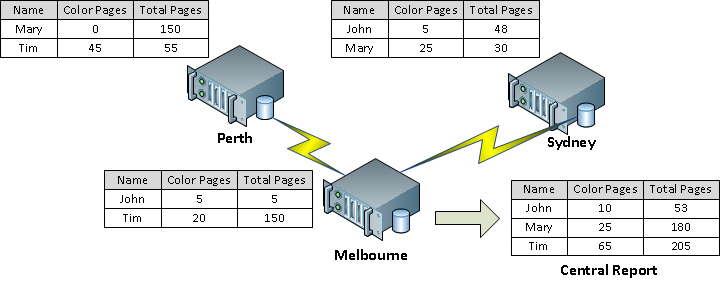Table of Contents
Early Access Program
Central Reports is currently offered under an Early Access Program. It has been extensively tested pre-release and there is a high level of confidence in its quality. However, as all customer scenarios are different we seek the assistance of our customers and partners to help ensure that any problems encountered are reported and addressed. We ask that customers:
Be aware that some issues may exist with Central Reports.
Work with PaperCut Software to quickly address issues if they occur.
During the early access period you should check the following PaperCut knowledge base article discussing any known issues: http://support.apposite.com.hk/Knowledgebase/List/Index/49/papercutMain/KnownIssuesCentralReporting
Organizations with multiple sites will typically follow one of two deployment strategies: centralized or decentralized. This includes businesses with offices in multiple cities and education institutes with international campuses. Each model comes with its own pros and cons.
One advantage of the decentralized model is that a system administrator at one site can't inadvertently make changes that affect the other sites. Poor inter-site link reliability and simplified site administration are other motivators for adopting the decentralized model. The main disadvantage of decentralization is the difficulty of gaining a unified view of print data and reporting. Central Reports solves this problem.
This chapter covers how Central Reports provides you with a consolidated data and reporting view across multiple primary/application servers (decentralized model). If you are using a single application server (centralized model) this is not required as the regular reports provide the data you need - see Chapter 9, Reports.
A typical scenario is an organization with multiple sites and one application server per site. With Central Reports organizations like this can access consolidated reports for the entire organization.
Central Reports works by running the same SQL query on all remote PaperCut databases and consolidating the result. This is done by first concatenating the result data from all databases, then grouping, sorting and aggregating as appropriate. For this purpose, entities such as users, groups, printers and accounts are matched by name. For example, if print usage records matching username "Mary" are received from multiple sites, they are all considered as coming from the same user and are aggregated. In other words, users (and some other entities) are considered to be unique across all sites.
We've taken most reports that are suitable for aggregation across systems and made them available in Central Reports. This includes the Executive Summary report and most usage reports. Not included are configuration reports, transaction reports and print log reports.
Central Reports may be scheduled for automatic generation and email distribution just like standard reports and we anticipate that most customers will want to use Central Reports in this way.
Tip
Central Reports is not a centralized management system. Your multiple PaperCut application servers must continue to be operated and managed independently. All configuration and balances remain local to each application server, including user and shared account configuration, admin rights and user balances.
